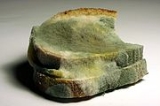
Black bread mold
Encyclopedia
Rhizopus stolonifer is a widely distributed thread-like Mucoralean mold
. Commonly found on bread surfaces, it takes food and nutrients from the bread and causes damage to the surface where it lives.
Asexual spores are formed within pinhead-like sporangia
, which break to release the spores when mature. Germination of these spores forms the haploid hyphae of a new mycelium. R. stolonifer grows rapidly at temperatures between 15 and 30°C.
Rhizopus stolonifer is a heterothallic
species (Schipper 1984), in that sexual reproduction happens only when opposite mating types (designated + and -) come in contact. Successful mating results in the formation of durable zygospores at the point of contact. Subsequently, the zygospore germinates and forms a sporangiophore whose sporangium contains both + and - haploid spores.
There are two varieties: R. stolonifer var. stolonifer produces straight, erect sporangiophores, whereas those of R. stolonifer var. lyococcos are curved. A closely related species, Rhizopus sexualis, differs primarily in being homothallic
(self-compatible).
. It is capable of causing opportunistic infection
s of humans (zygomycosis).
It is most commonly found growing on bread and soft fruits such as bananas and grapes. Because its spores are common in the air, it can often be grown within a few days by keeping moistened pieces of bread in an enclosed, humid environment.
Mold
Molds are fungi that grow in the form of multicellular filaments called hyphae. Molds are not considered to be microbes but microscopic fungi that grow as single cells called yeasts...
. Commonly found on bread surfaces, it takes food and nutrients from the bread and causes damage to the surface where it lives.
Asexual spores are formed within pinhead-like sporangia
Sporangium
A sporangium is an enclosure in which spores are formed. It can be composed of a single cell or can be multicellular. All plants, fungi, and many other lineages form sporangia at some point in their life cycle...
, which break to release the spores when mature. Germination of these spores forms the haploid hyphae of a new mycelium. R. stolonifer grows rapidly at temperatures between 15 and 30°C.
Rhizopus stolonifer is a heterothallic
Heterothallic
Heterothallic species have sexes that reside in different individuals....
species (Schipper 1984), in that sexual reproduction happens only when opposite mating types (designated + and -) come in contact. Successful mating results in the formation of durable zygospores at the point of contact. Subsequently, the zygospore germinates and forms a sporangiophore whose sporangium contains both + and - haploid spores.
There are two varieties: R. stolonifer var. stolonifer produces straight, erect sporangiophores, whereas those of R. stolonifer var. lyococcos are curved. A closely related species, Rhizopus sexualis, differs primarily in being homothallic
Homothallic
Homothallic refers to the possession, within a single organism, of the resources to reproduce sexually.It can be contrasted to heterothallic.It is often used to categorize fungi. In yeast, heterothallic cells have mating types a and α...
(self-compatible).
Distribution and habitat
Rhizopus stolonifer has a cosmopolitan distributionCosmopolitan distribution
In biogeography, a taxon is said to have a cosmopolitan distribution if its range extends across all or most of the world in appropriate habitats. For instance, the killer whale has a cosmopolitan distribution, extending over most of the world's oceans. Other examples include humans, the lichen...
. It is capable of causing opportunistic infection
Opportunistic infection
An opportunistic infection is an infection caused by pathogens, particularly opportunistic pathogens—those that take advantage of certain situations—such as bacterial, viral, fungal or protozoan infections that usually do not cause disease in a healthy host, one with a healthy immune system...
s of humans (zygomycosis).
It is most commonly found growing on bread and soft fruits such as bananas and grapes. Because its spores are common in the air, it can often be grown within a few days by keeping moistened pieces of bread in an enclosed, humid environment.
External links
- Time lapse video of Rhizopus stolonifer attacking strawberries at the Cornell Mushroom Blog.
- An Informative, Heart-Warming Tale about Black Bread Mold General information, diagrams, growth video

